Thin Film Battery Market Research, 2032
The global thin film battery market was valued at $0.4 billion in 2022, and is projected to reach $2.5 billion by 2032, growing at a CAGR of 19.8% from 2023 to 2032.
Report Key Highlighters:
- The thin film battery market study covers 20 countries. The research includes a segment analysis of each country in terms of value ($million) for the projected period 2021-2031.
- The study integrated high-quality data, professional opinions and analysis, and critical independent perspectives. The research approach is intended to provide a balanced view of global markets and to assist stakeholders in making educated decisions in order to achieve their most ambitious growth objectives.
- Over 3,700 product literature, annual reports, industry statements, and other comparable materials from major industry participants were reviewed to gain a better understanding of the market.
- The thin film battery market is highly fragmented, with several players including Angstrom Engineering Inc., Enfucell, Excellatron, Front Edge Technology, Inc., Imprint Energy, LG Chem, Molex, NEC Corporation, Soleras Advanced Coatings, and STMicroelectronics.
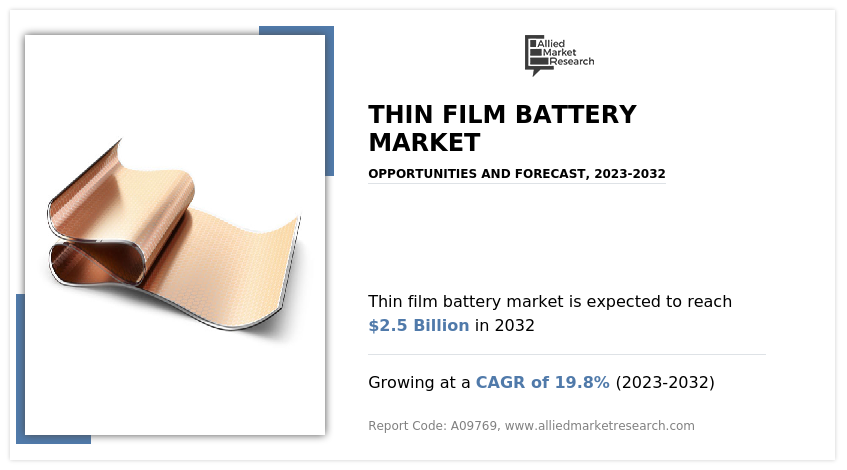
Thin film battery, known as solid-state battery, is a type of battery that utilizes thin films of solid-state materials as electrolytes and electrodes. These batteries offer several advantages over traditional liquid electrolyte batteries, including higher energy density, improved safety, and the potential for flexible and customizable form factors. Due to these unique characteristics, thin film batteries have found applications in various domains, ranging from consumer electronics to medical devices and wearable technology.
In essence, a thin film battery consists of multiple layers of thin films deposited onto a substrate. These layers typically include the positive electrode (cathode), the negative electrode (anode), and the solid-state electrolyte. The solid-state electrolyte enables the transport of ions between the positive and negative electrodes, facilitating the flow of electric current. The choice of materials for these layers greatly influences the performance and properties of the battery.
One significant thin film battery opportunities is their high energy density and long lasting power sources. This means that they can store a large amount of energy in a compact form, making them ideal for small, portable devices. For instance, in the consumer electronics domain, thin film batteries can power smartwatches, fitness trackers, and other wearable devices. Their thin and flexible nature allows for seamless integration into these compact devices, providing a reliable and long-lasting power source.
Moreover, the solid-state design of thin film batteries enhances safety compared to traditional liquid electrolyte batteries. The absence of flammable or volatile materials reduces the risk of leakage, fire, or explosion. This safety aspect is crucial in various applications, especially in medical devices such as pacemakers or implantable sensors, where reliability and patient safety are paramount. Thin film batteries can provide a stable and long-lasting power supply for these critical devices, ensuring patient well-being and reducing the need for frequent battery replacements.
In addition to consumer electronics and medical devices, thin film batteries find applications in the aerospace and defense industries. The lightweight and high energy density of these batteries make them suitable for powering small satellites, unmanned aerial vehicles (UAVs), or remote sensors in harsh environments. Their solid-state nature ensures stable operation and resistance to vibration, temperature fluctuations, and other environmental factors that these applications may encounter.
Thin film batteries have a remarkable life cycle, indicating the number of charge-discharge cycles they can endure without a significant decline in performance. These batteries can maintain their durability and reliability over a long period, offering hundreds or even thousands of cycles when handled with care. The ongoing trend of miniaturization in the electronics industry is driving the demand for compact and lightweight power sources. Thin film batteries offer a compelling solution due to their thin and flexible nature, making them an ideal fit for miniature devices such as smartphones, smartwatches, and IoT devices.
IoT devices often require small, wireless sensors that can operate autonomously for extended periods. Thin film battery industry offers a compact and efficient power solution for these sensors. Their ability to be integrated into flexible and custom form factors allows for seamless integration into IoT devices. These batteries can power wireless sensors for environmental monitoring, asset tracking, or smart home applications, enabling the growth of the IoT ecosystem.
The increase in demand for wearable devices drives thin film battery market growth.
Wearable devices, including smartwatches and fitness trackers, rely on thin-film batteries due to their lightweight and flexible nature. These batteries are made using advanced manufacturing techniques and may be customized to fit different shapes and sizes. They seamlessly integrate into wearable devices without compromising comfort or aesthetics. Thin film batteries offer enhanced safety compared to traditional lithium-ion batteries. This is primarily attributed to their solid-state electrolytes, which eliminate the potential risks of leakage and combustion.
In addition to improved safety, these batteries also exhibit rapid charging capabilities and high energy efficiency. The latest smartwatches are equipped with advanced capabilities such as heart rate monitoring and GPS tracking. They rely on a reliable and long-lasting power source to ensure continuous operation. Similarly, medical devices such as glucose monitors and drug delivery patches also require compact yet efficient power solutions to function effectively.
The rise in the use of thin film batteries in energy harvesting is expected to boost the market for thin film batteries during the forecast period.
Energy harvesting is a sustainable method of capturing and utilizing ambient energy from the surroundings to power electronic devices. It eliminates the need for traditional power sources such as batteries or grid connections. Various sources of ambient energy, such as light, heat, vibration, and radiofrequency signals, can be harnessed.
Thin film batteries, which are lightweight and flexible, are suitable for integrating into small devices without adding bulk. They are especially beneficial for wireless sensor networks in remote or inaccessible areas, as they can harvest energy from the environment, eliminating the need for wired connections or frequent maintenance. In June 2021, Salunda introduced a wireless sensor network for the oil and gas industry, ensuring the security of critical production, operational, and safety systems.
The thin film battery market size is segmented into chargeability, voltage, application, and region. On the basis of chargeability, the market is bifurcated as rechargeable and disposable. As per voltage, the market is divided into below 1.5V, 1.5V to 3V, and above 3V. According to application, the market is divided into wearable devices, medical devices, consumer electronics, smart cards, and others. Region-wise, the market is studied across North America, Europe, Asia-Pacific, and LAMEA.
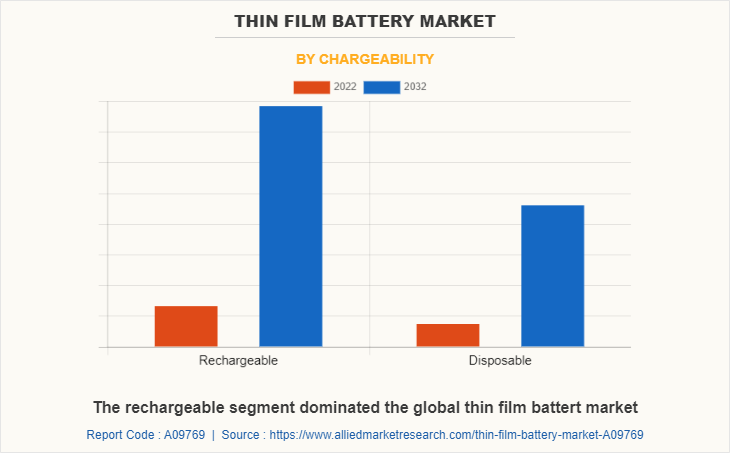
Thin film rechargeable batteries provide numerous benefits compared to conventional rechargeable batteries. They possess characteristics such as flexibility, lightweight construction, and the capacity to be manufactured in diverse shapes and sizes. These attributes make them exceptionally suitable for application in compact electronic devices, including smartphones, smartwatches, fitness trackers, and other wearable gadgets. Due to their thin and flexible structure, they can be seamlessly integrated into these portable devices without contributing significant weight or bulk.
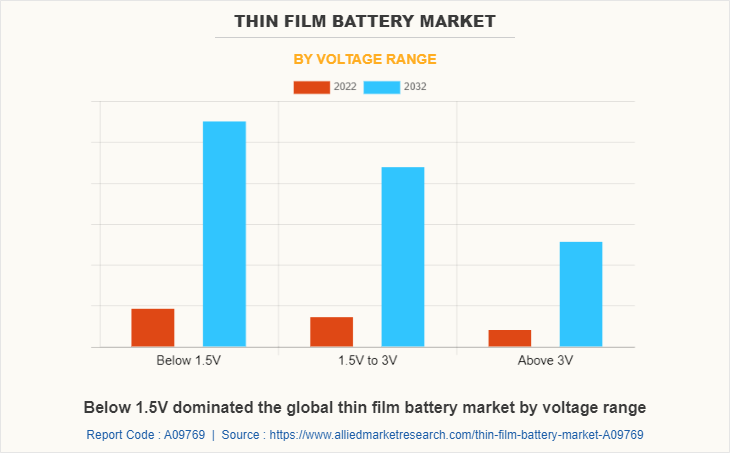
Thin film batteries with voltages below 1.5V are specifically engineered for use in compact applications like wearable electronics, smart labels, and medical devices. These batteries are suitable for devices that consume low amounts of power and offer excellent battery backup. One particular application of these batteries is in Radio Frequency Identification (RFID) tags, which are utilized for tracking and identification purposes. By utilizing thin film batteries with voltages below 1.5V, these RFID tags can effectively transmit data wirelessly.
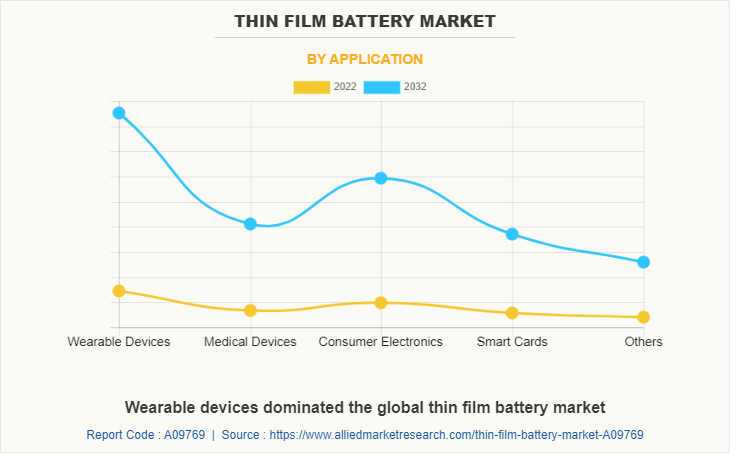
Thin film batteries have gained popularity in the realm of wearable devices, particularly in smartwatches, owing to their compact nature, flexibility, and capacity to deliver dependable power in small sizes. These batteries are perfectly suited for smartwatches as they seamlessly fit into the device's sleek and slim design, offering a lightweight yet efficient power solution. With the diverse range of features found in smartwatches, including heart rate monitoring, GPS tracking, notifications, and display functionality, the need for a reliable power source becomes crucial, and thin film batteries fulfill this requirement effectively.
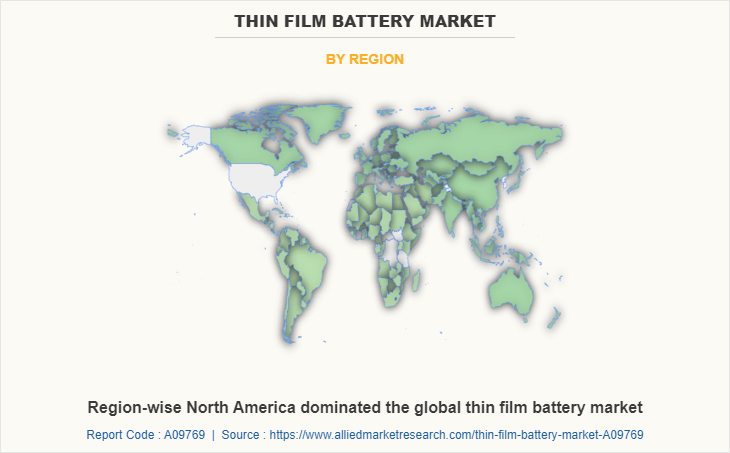
Thin film batteries have emerged as a promising technology with numerous applications across various industries in North America. Particularly in the electronics industry, these batteries offer distinct advantages that make them highly sought-after. One notable area where thin film batteries excel is in powering wearable devices, including smartwatches, fitness trackers, and medical monitoring devices, which enjoy significant popularity in the U.S.
The major players operating in the thin film battery market include Angstrom Engineering Inc., Enfucell, Excellatron, Front Edge Technology, Inc., Imprint Energy, LG Chem, Molex, NEC Corporation, Soleras Advanced Coatings, and STMicroelectronics.
Historical Trends of Thin Film Battery:
- The concept of thin film batteries began to take shape in the 1970s when researchers started exploring the potential of using thin film technology for energy storage applications.
- During the 1980s, advancements in thin film deposition techniques and materials paved the way for the development of thin film batteries. Research and development efforts were focused on improving the performance and scalability of these batteries.
- In the 1990s, several companies and research institutions started commercializing thin film batteries. Innovations in materials and manufacturing processes led to improved energy densities and the ability to produce thin film batteries in large quantities.
- The 2000s witnessed significant progress in the field of thin film batteries. Companies such as Cymbet Corporation and Infinite Power Solutions emerged as key players in the market, introducing thin film batteries for various applications such as medical devices, wireless sensors, and smart cards.
- The 2010s marked a period of rapid growth for thin film batteries. Advancements in materials, energy density, and manufacturing techniques further expanded the potential applications of these batteries. Thin film batteries found applications in wearable devices, Internet of Things (IoT) devices, and even in some consumer electronics products.
- In 2011, Enfucell launched its SoftBattery technology, which enabled the production of flexible thin film batteries. These batteries found applications in wearable electronics, medical devices, and interactive packaging.
- In 2019s, researchers at the University of California, Berkeley, developed a flexible, wearable thin film battery that could be powered by sweat. This innovation opened up possibilities for self-powered wearable electronics that could continuously monitor health parameters.
Key Benefits For Stakeholders
- This report provides a quantitative analysis of the market segments, current trends, estimations, and dynamics of the thin film battery market analysis from 2022 to 2032 to identify the prevailing thin film battery market opportunities.
- The market research is offered along with information related to key drivers, restraints, and opportunities.
- Porter's five forces analysis highlights the potency of buyers and suppliers to enable stakeholders make profit-oriented business decisions and strengthen their supplier-buyer network.
- In-depth analysis of the thin film battery market share assists to determine the prevailing market opportunities.
- Major countries in each region are mapped according to their revenue contribution to the global thin film battery market forecast report.
- Market player positioning facilitates benchmarking and provides a clear understanding of the present position of the market players.
- The report includes the analysis of the regional as well as global thin film battery market trends, key players, market segments, application areas, and market growth strategies.
Thin Film Battery Market Report Highlights
| Aspects | Details |
| Market Size By 2032 | USD 2.5 billion |
| Growth Rate | CAGR of 19.8% |
| Forecast period | 2022 - 2032 |
| Report Pages | 300 |
| By Chargeability |
|
| By Voltage Range |
|
| By Application |
|
| By Region |
|
| Key Market Players | Enfucell, Excellatron, STMicroelectronics N.V., Imprint Energy, NEC CORPORATION, Front Edge Technology, Inc., Angstrom Engineering Inc, LG Chem, Soleres Advanced Coating, Molex |
Analyst Review
According to the opinions of various CXOs of leading companies, the global thin film battery market was dominated by the wearable devices segment. Thin film batteries are highly advantageous for wearable medical devices such as glucose monitors, ECG monitors, and drug delivery systems. This is primarily because of their flexible and low-profile design. By incorporating these batteries into wearable patches or other compact forms, users can benefit from continuous monitoring and treatment while maintaining their freedom of movement.
The thin film battery market is driven by an increase in demand for thin film batteries in wearable devices. Thin film batteries have gained significant popularity in recent years as wearable devices have become increasingly popular. These batteries are specifically designed to meet the unique requirements of wearable technology, offering advantages such as small size, lightweight design, and flexibility. They can be easily customized to fit different shapes and sizes, making them an ideal choice for integration into wearable devices. They are manufactured using advanced techniques such as vapor deposition and sputtering, which allow thin layers of active materials to be deposited on substrates, creating a compact power source.
However, the limited energy density of thin film battery industry is expected to restrain industry expansion. Thin film batteries have lower energy density than conventional lithium-ion batteries, making them less suitable for applications requiring high energy storage, such as electric vehicles and large-scale energy storage systems. Energy density refers to the amount of energy that may be stored in a given volume or mass of the battery. In comparison, lithium-ion batteries have a higher energy density, enabling them to store more energy and deliver higher power outputs, which makes them better suited for applications demanding a large amount of energy, such as electric vehicles.
The Nort America region is projected to register robust growth during the forecast period. Thin film batteries are widely utilized in various applications within the military sector, including portable and wearable electronics, unmanned aerial vehicles (UAVs), and soldier systems. One of the key advantages of these batteries is their lightweight composition, which proves highly beneficial in reducing the overall weight carried by soldiers and equipment.
Angstrom Engineering Inc., Enfucell, Excellatron, Front Edge The top companies to hold the market share in thin film battery Technology, Inc., Imprint Energy, LG Chem, Molex, NEC Corporation, Soleras Advanced Coatings, and STMicroelectronics.
The surge in demand for medical implants is the upcoming trends of the thin film battery market in the world.
Wearable devices, medical devices, consumer electronics, smart cards, and others are the leading application of the thin film battery market.
Increase in demand for thin film batteries in wearable devices and the rise in the use of thin film batteries in energy harvesting are the driving factors of the thin film battery Market.
North America is the largest regional market for thin film battery.
Environmental concerns with respect to thin film battery are the is the obstacle faced by thin film battery market.
The Thin Film Battery Market was valued for $0.4 billion in 2022, and is projected to reach $2.5 billion by 2032, growing at a CAGR of 19.8% from 2023 to 2032.
Loading Table Of Content...
Loading Research Methodology...



